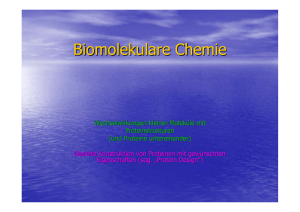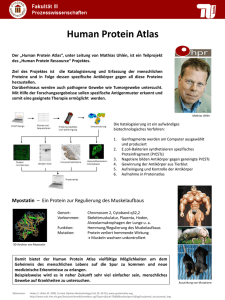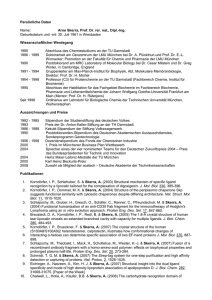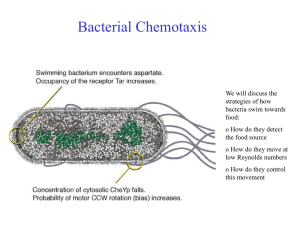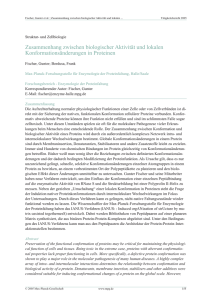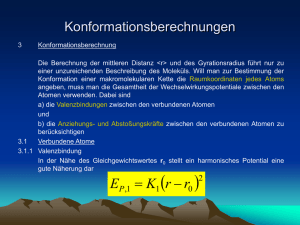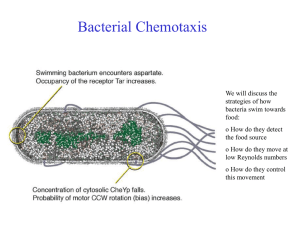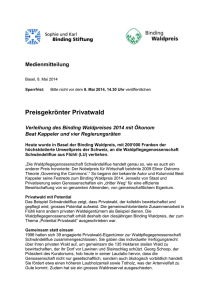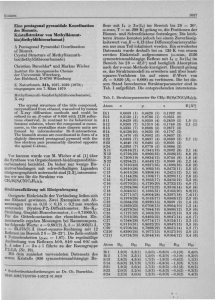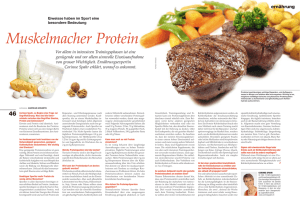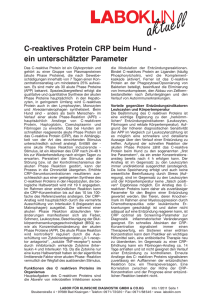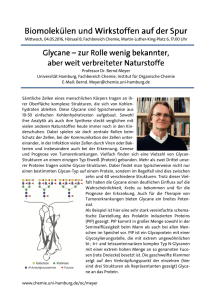NMR Studies on the Structure and Function of - ETH E
Werbung
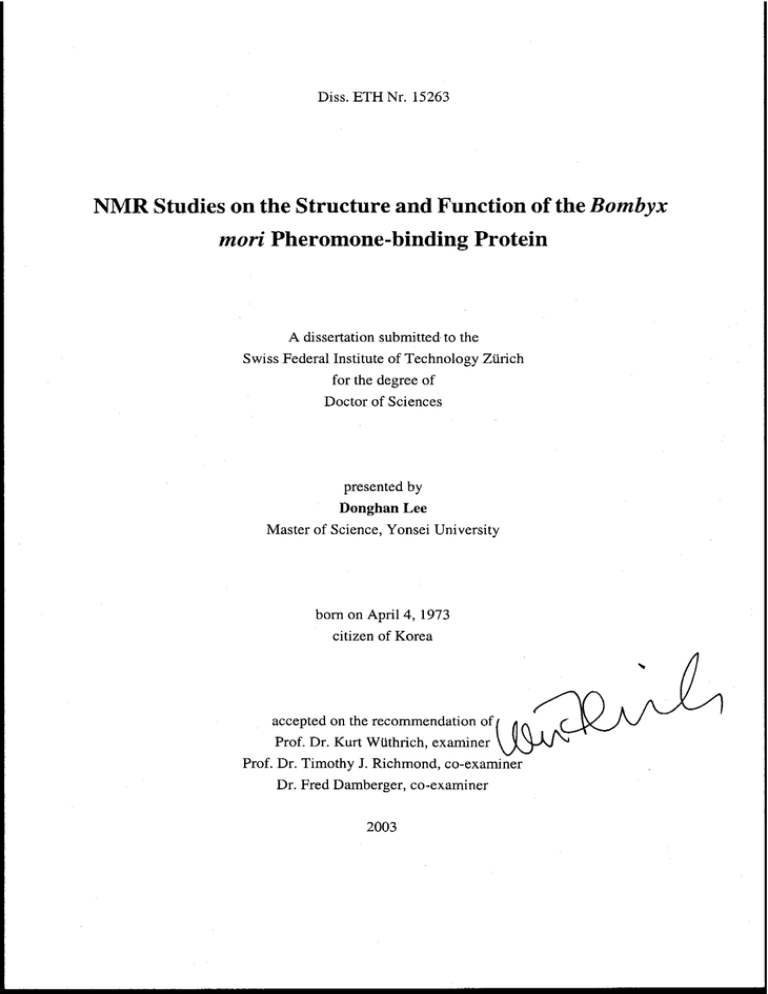
Diss. ETH Nr. 15263 NMR Studies on the Structure and Function of the Bombyx mori Pheromone-binding Protein A dissertation submitted to the Swiss Federal Institute of Technology Zürich for the degree of Doctor of Seiences presented by Donghan Lee Master of Science, Yonsei University born on April 4, 1973 citizen of Korea 2003 7 Summary Females of the silkwonn moth Bombyx mori produce a linear, partially unsaturated 16-carbon a1cohol (bombykol) as a pheromone that is recognized by the male. In the sensory organs of the male B. mori, bombykol is transported through the sensillar lymph to the olfactory receptors by the pheromone-binding protein, BmPBP, which occurs at high concentrations in moth olfactory hairs. The crystal structure of BmPBP complexed with bombykol shows that the ligand is completely enclosed in the core of the protein. This structure leaves open by which mechanism the ligand enters and exits BmPBP. Nuclear magnetic resonance (NMR) and circular dichroism spectroscopic investigations have shown that BmPBP undergoes a pH-dependent confonnational transition between the fonns BmPBpA present at pR 4.5 and BmPBpB present at pR 6.5. In order to obtain a more complete picture of the mode of action of BmPBP, we investigate the relationship between the pH-dependent confonnational changes and the ligand-binding mechanism of BrnPBP. BmPBpB consists of seven helices with residues 3-8,16-22,29-32,46-59,70-79, 84-100, and 107-124. The polypeptide fold encloses a large hydrophobie cavity, with a sufficient volume to accommodate the natural ligand bombykol. The backbone confonnations in free BrnPBpB and in the crystal structure of a BmPBP-bombykol complex are nearly identieal, indicating that the B-fonn of BmPBP in solution represents the active confonnation for ligand binding. The C-tenninal dodecapeptide segment, which is in an extended confonnation and located on the protein surface in BmPBpB, fonns a regular helix, a7, whieh is located in the pherornone-binding site in the core of the unliganded BrnPBpA. Because investigations by others indicate that the pH value near the membrane surface is reduced with respect to the bulk sensillar lymph, the pH-dependent confonnational transition of BmPBP suggests a novel physiologie al mechanism of intramolecular regulation of protein function, with the fonnation of a7 triggering the release of the pheromone from BmPBP to the membranc-standing receptor. Furthennore, the NH exchange rates in BmPBP show that the C-tenninal helix present in the A-form at pH 4.5 spends 0.2% of the time in flexibly extended confonnations. In order to examine the role of the C-tenninal helix in both the pH-dependent confonnational change and in the mechanism of ligand binding and 8 release, we studied the pH-dependence of the BmPBP-bombykol complex from both the protein side as wen as the bombykol side. Our results show that bombykol is not able to bind BmPBP at low pH and that the pH-dependent conformational change is preserved in the presence of bombykol. Three histidine sidechains (69, 70, and 95) form a cluster in BmPBpB and are more distant from one another in BmPB~. This suggests that the protonation of one or more of these histidines might induce the conformational transition from BmPBpB to BmPBp'\. To examine this hypothesis, we monitored the pH-titration of the histidine sidechains, and based on these results prepared a point mutant in which H69 is replaced by Alanine (BmPBP(H69A». The pH-titration of the backbone amide groups shows that the transition midpoint for the conformational change is lowered from 5.4 for BmPBP to 5.2 for BmPBP(H69A). This suggests that the charge repulsion of the three histidines at lower pH values may indeed contribute significantly to the pH-dependent conformational changes of BmPBP. We have also examined the role of the helix directly by preparing a truncated form of BmPBP (BmPBP(I-128», which is devoid of the C-terminal segment, and comparing its ligand binding to that of the wildtype protein. Analysis of the ligand binding studies of BmPBP(l-128) and comparison to the results for the wildtype protein suggest a novel mechanism of ligand binding and release. The hydrophobie cavity is only accessible at high pH when the "binding" loop between helices 2 and 3 (residues 3345) is flexible. At low pH, bombykol is ejected by the insertion of the C-terminal helix when the "release" loop (residues 56-83) is in an open state and the "binding" loop is rigid. Thus in a cycle of ligand binding and release the ligand appears to enter the binding site from one face of the protein and exit via the opposite face. 9 Zusammenfassung Weibliche Seidenraupenmotten der Gattung Bombyx mori produzieren emen linearen, teilweise ungesättigten Alkohol mit einer Länge von 16 Kohlenstoffatomen (Bombykol). Dieses Molekül wirkt als Pheromon, welches vom Männchen erkannt wird. In den sensorischen Organen der männlichen Motte wird Bombykol durch die sensilare Lymphe zu den olfaktorischen Rezeptoren transportiert. Dies geschieht mittels des Pheromon-bindenden Proteins, BmPBP, welches in hohen Konzentrationen in den olfaktorischen Häärchen der Motte auftritt. Die Kristallstruktur des Komplexes von BmPBP mit Bombykol zeigt, dass der Ligand vollständig im Kern des Proteins eingeschlossen ist. Diese Struktur lässt die Frage offen, durch welchen Mechanismus der Ligand ins Protein eindringt, und wie er es wieder verlässt. Kernspinresonanz (NMR) und Zirkulardichroismus Untersuchungen haben gezeigt, dass BmPBP eine pR abhängige Konformationsänderung zwischen den Formen BmPBpA bei pR 4.5 und BmPBpB bei pH 6.5 erfährt. Um ein vollständigeres Bild der Funktion von BmPBP zu erhalten, untersuchten wir den Zusammenhang zwischen der pR abhängigen Konformationsänderung und der Ligand-bindenden Funktion von BmPBP eingehender. BmPBpB besitzt sieben alpha-helizes, die aus den Aminosäureresten 3-8, 16-22, 29-32, 46-59, 70-79, 84-100 und 107-124 bestehen. Die Anordnung der Polypeptidkette ergibt einen hydrophoben Hohlraum mit einem Volumen, das es erlaubt, den natürlichen Liganden Bombykol unterzubringen. Die Faltung der Polypeptidkette im freien BmPBpB und in der Kristallstruktur des Komplexes von BrnPBP mit Bombykol ist fast identisch und legt die Vermutung nahe, dass die B-Form von BmPBP die aktive Konformation für die Ligandbindung darstellt. Das Csterminale Dodecapeptid, das in BmPBpB eine ausgestreckte Konformation annimmt und sich auf der Proteinoberfläche befindet, bildet in der nicht bindenden BmPBpA-Form eine alpha helix, a7, die den Pheromon bindenden Hohlraum im Kern des Proteins ausfüllt. Untersuchungen von anderen Forschungsgruppen weisen darauf hin, dass der pR Wert der Lymphe nahe der Membran tiefer liegt als in der Umgebung. Deshalb deutet die pR abhängige Konformationsänderung von BrnPBP mit der Bildung von a7, welche die Freigabe des Pheromons von BmPBP auf einen membranständigen Rezeptor auslöst, auf einen neuartigen, physiologischen Mechanismus zur intramolekularen Regulation 10 der Proteinfunktion hin. Weiter belegen Daten betreffend den Austausch von Amidprotonen bei pH 4.5, dass die C-terminale Helix 0.2% der Zeit in flexibel ausgestreckten Konformationen vorliegt. Um die Rolle der C-terminalen Helix sowohl beim pH abhängigen Konformationsübergang als auch beim Bindungs- und Freigabemechanismus zu untersuchen, studierten wir die pH-Abhängigkeit des BmPBP-Bombykol Komplexes von beiden Seiten: vom Protein und von Bombykol aus. Unsere Resultate zeigen, dass Bombykol nicht in der Lage ist, BmPBP bei niedrigem pH zu binden und dass die pH abhängigen Konformationsänderungen auch in Anwesenheit von Bombykol beibehalten werden. Drei Histidinreste (69, 70 und 95) liegen in BmPBpB räumlich nahe beieinander und weisen hingegen in BmPBfA grössere Abstände untereinander auf. Dies deutet darauf hin, dass die durch Protonierung eines oder mehrerer Histidine verursachte Ladungsänderung den Konformationsübergang von BmPBpB zu BmPBfA verursacht. Um diese Hypothese zu prüfen, wurde das Verhalten der Histidin Seitenketten während einer pH-Titration untersucht. Basierend auf diesen Resultaten wurde eine Punktmutante, BmPBP(H69A), hergestellt, in welcher Histidin 69 durch Alanin ersetzt wurde. Der Mittelpunkt des Konformationsübergangs während der pH-Titration der Rückgrat- Amidgruppen liegt bei BmPBP(H69A) mit pH 5.2 tiefer als bei BmPBP mit pH 5.4. Dies deutet darauf hin, dass die gegenseitige elektrostatische Abstossung der drei Histidine bei tieferem pHWert eine bedeutende Rolle bei der Konformationsänderungen von BmPBP spielt. Wir haben auch die Rolle der Helix a7 untersucht, indem wir eine verkürzte Form von BmPBP hergestellt haben, BmPBP(l-128), bei welcher das C-terminale Segment fehlt. Deren Bindung des Liganden haben wir mit der des Wildtyps verglichen. Die Analyse der Ligandbindungsstudien mit BmPBP(l-128) deutet auf einen neuartigen, Mechanismus der Ligandbindung und -freigabe hin: Der hydrophobe Hohlraum im Innern des Proteins ist nur bei hohem pH zugänglich, wenn die "Bindungs-Schleife" zwischen Helizes 2 und 3 (Aminosäurereste 33-45) flexibel ist. Bei tiefem pH wird Bombykol von der eindringenden C-terminalen Helix hinaus gestossen, wenn sich die "Freigabe-Schleife" (Aminosäurereste 56~83) in einer offenen Konformation befindet und die "Bindungs-Schleife" starr ist. Demzufolge scheint der Ligand in einem Bindungszyklus von der einen Seite des Proteins in die Bindungsstelle zu gelangen und diese über die entgegengesetzte Seite wieder zu verlassen.
